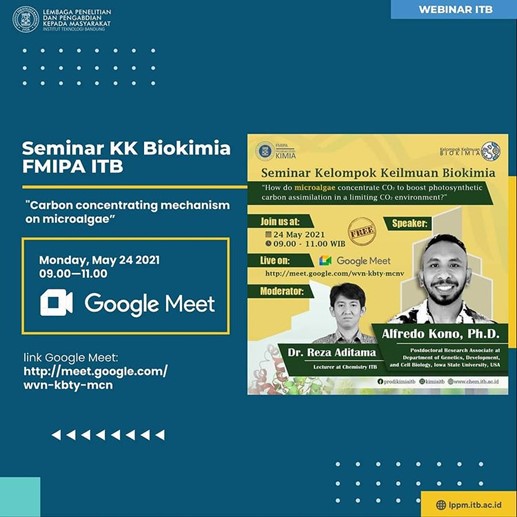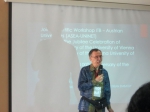Get to Know CCM: Microalgae’s Unique Mechanism in Unsuitable Environment
By Adi Permana
Editor Adi Permana

BANDUNG, itb.ac.id – How do microalgae concentrate CO2 to boost photosynthetic carbon assimilation in a limiting carbon dioxide environment? Alfredo Kono, Ph.D. tried to answer this question in a webinar presented by Institut Teknologi Bandung (ITB) Biochemical Research Group on Monday (24/5/2021).
According to Alfredo, photosynthesis is both a crucial process for plant life and a very important biochemical reaction that sustains our existence. This is caused by the conversion of carbon dioxide gasses in the air into sugar, which later is used as the main energy source for living things. In addition, the photosynthesis process also emits oxygen.
However, there are some limiting factors that affect the photosynthesis process, such as the low concentration of carbon in the atmosphere and the lack of kinetic energy from the Rubisco enzyme.
These limiting factors also happen to aquatic plants. Aquatic plants possessed a greater challenge because of the low carbon dioxide concentration in their environment. The reason behind this is that carbon dioxide gasses have a longer diffusion duration in water than in air, and the pH fluctuates in water.
The pH level fluctuation will cause a negative impact if the carbonate content is higher than the carbon dioxide content because the Rubisco enzyme requires a high carbon dioxide concentration. “Microalgae solve this by creating a unique mechanism; CCM or CO2 concentrating mechanism,” he said.
There are several crucial components in the CCM mechanism. One of them is Ci transporters, a protein on the membrane cell that transports carbon dioxide and bicarbonate. After the materials have been transported and accumulated inside the cell, the carbonate contents will be converted into carbon dioxide by the carbonic anhydrases (CAs) enzyme. This process is needed because the Rubisco enzyme can only process carbon dioxide.
Rubisco enzymes in microalgae have a unique way to solve the lack of carbon dioxide in their environment. “To respond to the lack of carbon dioxide concentration in the environment, Rubisco enzymes will be concentrated in an organelle or specific microcompartments in the cell, so that microalgae can do the carbon dioxide fixation process.”
Not only very useful for aquatic plants, but the CCM mechanism of microalgae also has some other possible applications. The first one is the possibility of a modified and characterized microalgae CCM mechanism component to be engineered into C3 plants such as rice and cassava. If this is successfully implemented, it is expected that the rate of photosynthesis of C3 plants will increase significantly.
Another potential of CCM is that it can be utilized to absorb carbon dioxide gasses from the air, this process is known as CO2 mitigation system. “Another problem that can be solved by CCM is to increase the consumption of carbon dioxide especially for algae on the bioreactor.”
Reporter: Athira Syifa P. S. (Postharvest Technology, 2019)
Translator: Favian Aldilla (Civil Engineering, 2019)

.jpg)
.jpg)
.jpg)
.jpg)
.png)


